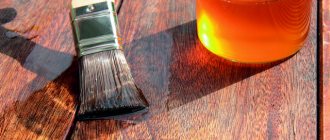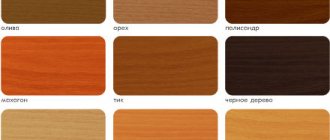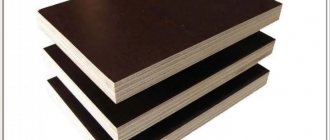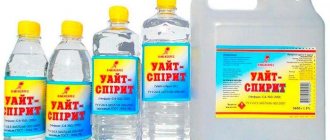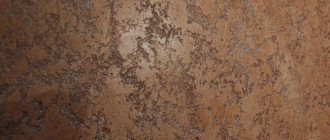The furniture surface is usually covered with a layer of varnish; this action allows you to obtain the necessary protection of wooden materials from the harmful influence of external factors. Without additional coating, the tree will not be able to retain its properties for a long time. It is important to choose furniture varnish for the conditions of use so that the treatment gives the best result. This will be discussed in detail in the article.
Technology of applying varnish to a wooden surface. How to varnish wood correctly?
How to apply varnish to wood?
Our company's technologists will tell you about this. It is best to call us as different products require different approaches. Frequently asked question: what is the best way to apply varnish to wood?
A spray gun is ideal for this purpose (an air gun for nitro varnishes and an airless gun for water painters), but if you don’t have one, you can use a brush or roller. Synthetic brushes are well suited for water-based products, and natural bristles for solvent-borne products.
First we prepare the surface. Hairiness and any shallow gouging defects are removed by sanding. Movements should be carried out in the direction of the fibers. It is best to use an eccentric machine for sanding. Primary processing is carried out with coarse grain 80, finishing with grinding with P 150-240 abrasive.
FAQ:
- How to varnish wood without streaks?
The varnish layer should be as thin as possible. To do this, the applied composition is poured into a paint bath, where excess varnish is removed using a rolling surface. Coloring control is carried out using a table lamp installed at the edge. The light falling on the wood will indicate where there is a lot of varnish and where there is none at all. - How many layers of varnish should be applied to wood?
Usually at least two layers are applied. Some paint schemes require three coats. Between layers it is necessary to maintain the time recommended by the manufacturer for drying. - Is it necessary to coat the wood with varnish after impregnation with primer?
If you need aesthetics, then varnish is needed. If a structure that is not visible is being processed, it is not advisable to apply a varnish composition, and a primer will provide effective protection.
No. 12. Alcohol varnish
These are not very common compositions, the scope of which is very limited. Alcohol varnishes (varnishes) are made based on ethyl alcohol and resins. The alcohol evaporates quickly, so the drying time of the varnish is minimal - from 20 minutes to an hour. The coating has a beautiful shine, but protects the surface very poorly from moisture. The composition is used in the processing of musical instruments , less often in carpentry for processing furniture .
Consumption of varnish per 1m2. Coverage schemes
The consumption of varnish per 1 m2 on wood depends on the density of the wood, the type of lumber (planed, sawn), the concentration of paintwork materials and pre-treatment. Typically, on a planed surface, consumption does not exceed 1 liter per 10 m2.
How to treat wood before varnishing so that the consumption of the latter is minimal?
To do this, use acrylic primer, which creates a film on the surface. The absorbency of lumber is reduced, and the consumption of varnish is small.
When painting with brushes, it is recommended to dilute the first layer of varnish with water so that its consistency becomes thinner. The approximate consumption rate of wood varnish per 1 m2 for the first layer is 130 ml. When applying varnish on the ground or as a second layer, the consumption can be halved.
Photo 7. Planken coated with Teknos varnish
Advantages of lacquered furniture
- Natural wood in its entirety is not only associated with ecology, but also looks attractive in any interior, no matter what style you choose. Varnishing - whether glossy or matte - gives the wood a touch of sophistication, nobility and some monumentality.
- The varnished surface is incredibly easy to clean, because any stains and fingerprints are erased in a second.
- In addition to external advantages, lacquered furniture is reliably protected from dirt, dust and moisture, as well as from accidental mechanical damage.
- One of the main advantages is the ease of restoration: there are special care products that we will look at a little later.
What is moisture-resistant varnish. Do I need to pay extra for it?
Moisture-resistant wood varnish does not allow moisture to pass through and does not release it back, as a result of which water does not accumulate under the film and does not destroy the paint layer. However, moisture-resistant varnish is more expensive, so it is advisable to use it in conditions with high humidity - a street where rain and snow have a detrimental effect on wood, a bathroom, a kitchen, a sauna. If the room is dry, there is no point in overpaying for moisture resistance.
Differences between fixing varnish and interior varnish
In order to most effectively use varnish for fixation, it is necessary to distinguish it from interior varnish and take into account the operating conditions of future objects of processing and the load on them. Although there are no big differences between fixing and interior varnishes, some manufacturers use the name “fixing” to emphasize the exclusive repair nature of the substance, as well as the fact that they are not recommended, for example, to cover parquet floors. As a result, fixing varnish coatings have the following main differences:
- Maximum permissible loads – application specifically to decorative pieces of furniture in order to preserve one or another of its designs/patterns, which does not imply intensive use of the object;
- The level of gloss is the frequent inclusion in the structure of the varnish of components that form a matte rather than glossy effect, because the former are less easily soiled and do not leave fingerprints;
- Operational options - for treating outdoor furniture, varnishes have in their structure mandatory components that resist negative atmospheric phenomena, temperature fluctuations and frequent changes in humidity;
- Shades – fixing substances can be either transparent or tinted. The latter are responsible for maintaining the color and even enhance it a little, however, the texture and pattern of the wood remain unchanged.
What varnishes have a smell? Is it harmful to human health?
Paints and varnishes based on organic solvents are endowed with a pungent odor that causes headaches, nausea or allergies in humans. Such symptoms indicate pathological processes in the body. Paintwork materials with a strong odor are certainly harmful. Such products must be used for their intended purpose, in specially equipped rooms with fresh ventilation.
Odorless, water-based wood varnish is an absolutely safe product for humans. Water-soluble varnishes are very popular today. They are environmentally friendly and have excellent technical characteristics. The coating is aesthetically pleasing, lasts a long time, and does not crack under the influence of sunlight.
Modern types of fixing varnishes
Oil based
A similar substance is designed to fix the appearance of wooden furniture, giving its surface a certain characteristic yellowish woody tint. The structure of the substance includes a solvent, various oils and resins. In the past, the composition included linseed oil, today synthetics are used. White spirit or turpentine may also be added. Characterized by a long drying process. The protective film formed is designed to prevent the appearance of fungus/mold, as well as fading in the sun. This coating is moisture-resistant and durable, as well as visually attractive. Great for treating garden furniture, fences or gazebos. In cases where processing is carried out in domestic conditions, it is necessary to pay attention to the presence of harmful/toxic substances in the composition and use protective equipment (respirator) during the process. Also, after hardening, the treated surface can be sanded, which will add additional shine.
Nitrocellulose base
The basis of this varnish is nitrocellulose. The composition contains resins and plasticizers, organic solvents and colloxylin. This substance can be used for repair work on furniture and is suitable for application to any type of wood. It is considered very safe and does not have an unpleasant odor. The drying process is very fast - within 45-60 minutes a hard film forms. The resulting coating has enhanced decorative properties and is considered the best means for fixing designs and decorations on a wooden surface. In addition, being quite durable and moisture-resistant, the varnish base can easily withstand polishing. However, it has a pronounced instability to the negative effects of the atmosphere. Hence the conclusion - this varnish is not intended for outdoor furniture. When performing processing, the use of protective equipment is required.
Water
Such varnishes are considered the most environmentally friendly and safe, because they contain absolutely no toxic substances. Recommended for processing children's furniture and furniture in medical institutions. After application, a coating is created on the surface that is characterized by increased strength and resistance to mechanical stress. Despite their water base, such varnishes are not able to withstand the effects of moisture - again, they are not recommended for outdoor furniture. They may contain one or two components. One-component ones do not require dilution or mixing with other substances (solvents), and the latter are produced using polyurethane, which increases their strength. The most popular means of fixation include water-based acrylic compounds. In its original form, this substance is white, but after application and drying, the water base evaporates, and the remaining resin forms a transparent layer. The main advantages of acrylic are:
- Complete security;
- No unpleasant odors;
- High level of fire safety;
- Quick drying;
- Preservation of the natural structure of wood;
- Increased strength.
However, such varnish should only be used in spaces where the ambient temperature is at least +20 degrees Celsius - otherwise the coating simply will not dry.
Polyurethane compounds
These include polyesters and isocyanates. Usually, they are performed on a water base, which makes it clear that they do not contain toxic substances. They are characterized by strength, moisture resistance, and elasticity, which extends their service life. The film is created with glossy shades, perfectly removes and resists chips and cracks. They can be used for wood of any species. They are excellent at resisting moisture, which makes such varnishes optimal for treating country furniture (gazebos, gardens, summer verandas, etc.). The polyurethane layer protects not only from water precipitation, but also from direct sunlight, as well as from temperature changes. However, there are a number of disadvantages:
- High price;
- Long drying period;
- During processing, a pungent odor is released.
Based on alkyd resins
Such varnish substances are created on the basis of synthetic resins and have the properties of strength, moisture resistance and transparency. They can be used on any type of wood and do not depend on the conditions under which the treatment is to be carried out. Perfect for covering country furniture. After hardening, the surface is covered with a transparent film that is resistant to negative atmospheric conditions. At the same time, the furniture acquires protection from mechanical damage and can withstand the destructive effects of some aggressive chemicals. The disadvantages of using alkyd varnish coatings include their long drying process - complete hardening of the substance occurs only 72 hours after treatment. Among other things, the product has a pungent odor, and the composition may contain toxic components - solvent, xylene, white spirit. The most durable example is considered to be an alkyd-urethane varnish, which can be used to cover not only furniture, but also parquet floors. Alkyd-urea products have a two-component composition and dry quickly.
Craquelure varnishes
This is a special varnish variety that is decorative and allows you to create the look of aged furniture. This sample can be used for working with antique objects. After the processing procedure, a surface with natural traces of cracking is formed. This effect becomes possible due to the fact that the coating and varnish have different drying periods. This option is used only when appropriate for interior design.
Consumption
In order to correctly calculate how many cans of varnish will be needed to treat a certain area, you should make some calculations.
First you need to pay attention to the criteria that play an important role when spending funds:
- Wood surface. Wood with fine pores always requires less varnish than surfaces with deep pores. For example, processing beech or pine will cost much less than painting ash or oak.
- Wood sanding quality. A well-polished surface always requires little varnish. For high-quality sanding of the material, you should use sandpaper with P100 grain. To create the second layer, use P220 sandpaper.
- Viscosity. Thick varnish will have a high consumption. To reduce it slightly, the first and second layers of application can be carried out with varnish diluted with a solvent. If the product is water-based, then you can add a little water to make it more liquid.
- Method of application. If you use spraying, the consumption will be minimal. Using a brush or roller increases the product consumption significantly.
On average, varnish consumption per 1 m² is 100–125 ml. It will take less to create a second coat of varnish. So, per 1 m² you will need only 80–100 ml. But the factors described above play a decisive role, so for an accurate calculation you can purchase a can of varnish, use it and measure the area. This will allow you to make a very accurate calculation.
No. 11. Polyester varnish
Multicomponent composition based on polyester resins. It is applied with a special gun and requires high professionalism and sufficient precision in work. After drying, a fairly thick, durable film is formed, which protects well from moisture and aggressive substances. Varnish is used to treat floors, furniture and some musical instruments.
Manufacturers
Today, many well-known companies offer a wide selection of high-quality wood varnishes.
Italian products are in great demand. Borma Wachs has established itself as a high-quality and reliable manufacturer of products intended for processing natural wood.
The Italian brand Sayerlack offers more than 3,500 items, which fully satisfies the needs of woodworkers and furniture manufacturers.
The Finnish company Tikkurila is a popular manufacturer of water-based varnishes for coating parquet boards. It uses exclusively new technologies and computerized equipment to create high-quality and reliable products. The brand offers a wide range of wood varnishes that are characterized by increased wear resistance.
The Swedish company Bona has been offering high-quality water-based paints and varnishes that do not have a characteristic odor for several decades. The brand has its own research center, where innovative products are developed.
This center developed a unique varnish made from polyurethane particles Traffic . It allows you to give the coating increased wear resistance, as well as protect it from mechanical influences, as a result, Traffic varnish is used to cover parquet in high-traffic areas.
The German brand Berger offers a wide range of water-based parquet varnishes, characterized by excellent quality. Berger Aqua-Seal polyurethane varnish is in great demand, which not only has increased wear resistance, but also protects wooden parquet from chemical attack. The only exceptions are nitro solvents, since they can damage the structure.
The Italian company Vermeister is a well-known manufacturer of water-based polyurethane varnishes, which include two components and are designed to create a matte, semi-matte and semi-gloss surface. Aqua Play 2K varnish hardens in just four hours. The company offers products at reasonable prices.
Instead of an epilogue
A study of the assortment of fixative varnishes on the Russian market found that most of it is occupied by the lower price segment, represented by domestic manufacturers. Budget prices are explained only by the small volume of the container in which the varnishes are supplied, since they are primarily intended for fixing/repairing various damages, rather than for fixing the decor applied to furniture. Moreover, these samples are applied with a brush and, with rare exceptions, are sprays. The middle segment turned out to be divided by both price and quality indicators. For repair work, the buyer prefers Russian high-quality aerosols, and for large-scale work, Western samples are already selected, which are applied either with a roller or a large brush. The price for both is approximately the same. The premium class is represented exclusively by foreign-made universal sprays, which have a considerable cost and are capable of both fixing decorative patterns and performing repair tasks.
Useful tips
To properly apply varnish to a wooden surface, you should follow simple rules:
- The surface of natural wood needs to be sanded.
- If the wood is coated with varnish or paint, then these layers must be removed. You can use sandpaper or a special remover.
- All dust must be removed after sanding.
- Prime the surface. This will avoid the formation of bubbles and other visual defects.
- Apply varnish to the wooden surface.
There are several ways to varnish a wooden surface:
- The brush is ideal for processing small parts, as well as for applying product in hard-to-reach places. To avoid streaks, you should use brushes that have “fluff” at the tips of the bristles.
- A roller is a good choice for applying varnish over large areas. When choosing a roller, you should give preference to models with a pile of no more than 5 mm.
- Spraying is a convenient way of painting using a spray gun and compressor. This option allows you not only to save varnish consumption, but also to quickly and easily treat even hard-to-reach places.
Before use, the varnish should be mixed thoroughly, especially if the product includes two components. This will have a positive effect on the durability of the coating.
If the varnish needs to be applied in several layers, then you need not only to wait for the previous layer to dry completely, but also to go over the coating with sandpaper and then remove all the dust.
The number of layers depends on what can be processed. For example, to paint furniture, two layers will be enough, but for flooring you will need to apply varnish three times.
Rules for applying varnish to furniture
Any type of varnish, liquid or aerosol, can only be applied to a prepared base; only then will the level of adhesion be high and an even layer will be obtained. It will be necessary to remove the old coating; grinding with electric tools can be used (set at low speeds so that the material is not damaged) or the application of special removers. You can use a heat gun to heat it up, after which the layer of old finish is removed with a spatula.
The surface is also sanded without the old coating to remove uneven parts and remove the unsightly aged layer of wood. Different sandpaper levels are used, starting with a coarser type and ending with fine sandpaper. As a result, an attractive wood pattern will remain on the surface.
It may be necessary to apply stains to obtain additional protection, as well as a primer solution to increase the level of adhesion and reduce paint consumption.
White furniture varnish is often chosen to highlight the base, creating an aged effect. Any varnish should be applied in a thin layer; a single layer is usually not enough for a good result; three layers are applied. After the first one, you will need to sand again; each layer should be thoroughly dried before applying a new one.
Before carrying out work, be sure to carefully study the instructions from the manufacturer; each composition may have its own application nuances.
Any varnish should be applied in a thin layer; a single layer is usually not enough for a good result; three layers are applied.
What is the difference between wood varnish for exterior and interior use?
Experts divide paint and varnish materials according to several criteria, one of which is operating conditions. Thus, products located in the open air are subject to the negative effects of natural factors, due to which the tree constantly swells and contracts. In this regard, varnishes for external use form an elastic film on the treated surfaces, which allows the wood to easily withstand regular changes in size.
At the same time, it is impossible to use compositions intended for interior work for these purposes - such materials do not have sufficient elasticity, and therefore will not be able to provide the surface with the necessary protection.
Functional Features
As a rule, fixing coatings are some combination of a special film-forming substance with an organic solvent. After drying, the surface of the furniture is covered with a transparent layer, and it can be given shades of matte/glossy shine. All the protective characteristics of the varnish will depend on its composition, in other words, its variety. With the help of the substances in question, furniture can be transformed and retain its original qualities for a long time, whether it is assembled from MDF or chipboard, plywood or wood. Basically, fixing varnishes are designed to perform the following functions:
- Adding a special shine to surfaces;
- Protection from pests, water and dirt;
- Preservation of color qualities;
- Giving furniture strength and durability;
- Resists swelling/cracking over time;
- Resistance to conditions of elevated temperatures, various atmospheric aggressive factors;
- Masking of some surface defects (hiding small chips, scratches or cracks);
- Preventing accidental injury to people (eg eliminating the risk of splinters).
Reviews: advantages and disadvantages
Varnishes for exterior use have a number of advantages, the main ones being: high protective performance and the ability to preserve the unique texture of wood. High-quality compositions have increased wear resistance, resistance to ultraviolet radiation and moisture. At the same time, the varnish coating also provides the wood with protection from rotting and fire, which has an extremely positive effect on the service life of the product.
Some experts and consumers consider the disadvantages of varnish compositions to be a rather long drying time - it often takes more than 24 hours to completely dry the coating.
Purpose
Furniture items made of wood and particle boards are actively used in home and office interiors. Under the influence of external negative factors, products can become deformed, crack, or become moldy. To protect and prevent loss of attractive appearance, special furniture varnishes are used. The products have a film-forming property, which manifests itself after applying the composition to the surface of the furniture and its complete drying. The finished product is coated with varnish at the final stage of processing.
Furniture varnishes can have different shades, matte or glossy finish, but their coating remains transparent or translucent. This allows you not to hide, but, on the contrary, to emphasize the natural beauty of the wood structure.
Depending on the degree of gloss of the coating, the following types of product are distinguished:
- Matte furniture varnish is practical and does not show fingerprints or stains at all. Matte surfaces are appropriate in business and office premises; they are combined with chrome fittings;
- Glossy coatings have a maximum degree of light reflection. Furnishings with a glossy shine often become the main accents of the interior. They look noble and elegant;
- Semi-gloss and semi-matte varnishes are universal. They are suitable for decorating any furniture, have a moderate shine and do not show much hand marks;
- Some products are suitable for garden furniture; they are resistant to moisture and contain substances that protect against the negative effects of UV rays.
Matte
Glossy
Semi-gloss
Where to buy wood varnish?
In Moscow
In Moscow, you can purchase varnish for exterior woodwork from companies such as:
- “Paints on the Sofa”: website: https://kraskinadivane.ru;
- address: Moscow, Taldomskaya street, building 17, building 1;
- telephone.
- website: https://stroycolorit.ru;
- website: https://www.krasko.ru;
In St. Petersburg
In St. Petersburg, the following organizations sell wood varnishes:
- “Petrovich”: website: https://petrovich.ru;
- address: St. Petersburg, 6th Verkhny lane, building 12A;
- telephone.
- website: https://olvia-color.ru;
- website: https://vlagoshchit.rf;
Thus, a properly selected varnish for exterior use can not only reliably protect wood from the harmful effects of external factors, but also preserve its natural texture almost unchanged.
In the next video you will find a review of Kudo KU-904x tinting varnish for wood.
Is it possible to use aerosol-type formulations?
Aerosol varnishes are widely represented on the construction market. Due to their ease of use and economical consumption, this option for applying compositions is becoming increasingly popular.
The varnish is not diluted before use; you just need to shake the can; the aerosol is kept at a distance of 20-30 centimeters from the surface. There are compositions for any wooden bases - MDF, pine, etc. Another plus is that you don’t need to prepare brushes and rollers for work.
The aerosol is kept at a distance of 20-30 centimeters from the surface.
Furniture varnish makes it possible to bring old furniture back to life by creating a new beautiful coating, as well as extend the life of the product by creating reliable protection from external factors. There are special compositions for working outdoors, which are distinguished by their increased resistance to precipitation, as well as safe types for working inside a building.
